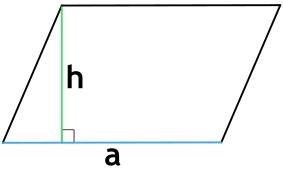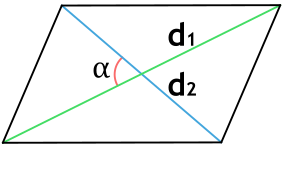
{S = a cdot h}
Найти площадь параллелограмма
На этой странице вы можете рассчитать площадь параллелограмма с помощью калькулятора по трем формулам. Просто введите известные вам данные — основание, высоту, стороны, диагонали и углы между ними и получите ответ.
Параллелограмм — это четырёхугольник, у которого противоположные стороны попарно параллельны (лежат на параллельных прямых).
Содержание:
- калькулятор площади параллелограмма
- формула площади параллелограмма через сторону и высоту
- формула площади параллелограмма через две стороны и угол между ними
- формула площади параллелограмма через диагонали и угол между ними
- примеры задач
Формула площади параллелограмма через сторону и высоту
{S = a cdot h}
a — сторона параллелограмма
h — высота параллелограмма
Формула площади параллелограмма через две стороны и угол между ними
{S=a cdot b cdot sin(alpha)}
a, b — стороны параллелограмма
α — угол между сторонами a и b
Формула площади параллелограмма через диагонали и угол между ними
{S = dfrac{1}{2} cdot d_1 cdot d_2 cdot sin(alpha)}
d1, d2 — диагонали параллелограмма
α — угол между диагоналями
Примеры задач на нахождение площади параллелограмма
Задача 1
Найдите площадь параллелограмма, стороны которого равны 9 см и 12 см, а угол между ними 60 градусов.
Решение
Для решения задачи нам подойдет вторая формула, так как из условия нам известны стороны параллелограмма и угол между ними. Подставим значения в формулу и произведем расчет.
S = a cdot b cdot sin(alpha) = 9 cdot 12 cdot sin(60) = 108 cdot sin(60) = 108 cdot 0.866 approx 93.53074 : см^2
Ответ: 108 cdot 0.866 approx 93.53074 : см^2
Мы можем проверить ответ с помощью калькулятора .
Задача 2
Найдите площадь параллелограмма, если две его стороны равны 8 см и 12 см, а угол между ними равен 30 градусов.
Решение
Задача похожа на предыдущую, поэтому ее решение будет выглядеть аналогично.
S = a cdot b cdot sin(alpha) = 8 cdot 12 cdot sin(30) = 96 cdot sin(30) = 96 cdot 0.5 = 48 : см^2
Ответ: 48 см²
И снова проверить ответ нам поможет калькулятор .
Задача 3
Найдите площадь параллелограмма, сторона которого равна 12 см, а высота проведенная к ней 8 см.
Решение
В этом случае нам известны сторона параллелограмма и высота, поэтому воспользуемся первой формулой.
S = a cdot h = 12 cdot 8 = 96 : см^2
Ответ: 96 см²
И снова проверить ответ нам поможет калькулятор .
Как рассчитать площадь параллелограмма
На данной странице калькулятор поможет рассчитать площадь параллелограмма онлайн. Для расчета задайте длину основания, высоту или длины диагоналей и угол между ними.
Параллелограмм — это четырёхугольник, у которого противоположные стороны попарно параллельны, то есть лежат на параллельных прямых. Частными случаями параллелограмма являются прямоугольник, квадрат и ромб.
Через основание и высоту
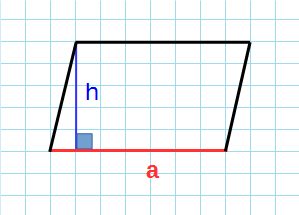
Формула для нахождения площади параллелограмма через основание и высоту:
a — длина основания; h — высота.
Через основания и угол между ними
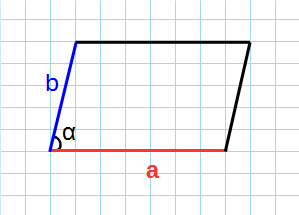
Формула для нахождения площади параллелограмма через основания и угол между ними:
a, b — длина основания; α — угол между основаниями.
Через диагонали и угол между ними
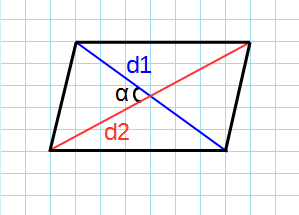
Формула для нахождения площади параллелограмма через диаганали и угол между ними:
d1, d2 — диагонали; α — угол между диагоналями.
Загрузить PDF
Загрузить PDF
Параллелограмм определяется как простой четырехугольник с двумя парами параллельных сторон. Если вы занимаетесь геометрией, то вам может понадобиться найти площадь параллелограмма. Вот несколько указаний как именно это сделать.
Шаги
-
1
Найдите основание параллелограмма. Основание – это длина нижней стороны параллелограмма.
-
2
Найдите высоту параллелограмма. Высота параллелограмма – это перпендикулярная линия, проведенная из произвольной точки верхней стороны к нижней стороне параллелограмма.
-
3
Умножьте основание на высоту.
Реклама
Об этой статье
Эту страницу просматривали 9149 раз.
Была ли эта статья полезной?
Download Article
Download Article
A parallelogram is a quadrilateral, or four-sided shape, with two sets of parallel sides. Squares, rectangles, and rhombuses are special types of parallelograms, though most people think of a «slanted» rectangle, with two diagonal sides and two flat sides, when they think of the parallelogram.[1]
No matter what the angle of the corners or the slant of the shape, it is easy to calculate the area of a parallelogram.
-
1
Multiply the base of the parallelogram by the height to find the area. If your problem gives you a measurement of the base and height of a parallelogram, simply multiply them to get your area. For example, if the base is 5, and the height 3, then your area is
, since
.[2]
- The base is the length of the long, flat side on the bottom.
- The height is the distance from the base straight up to its parallel side.
- Which side is the base and which is height is entirely up to you — you could rotate any parallelogram to make any side the bottom and still get the same final answer.[3]
-
2
Measure or record the length of the long, flat side, or base. A parallelogram consists of two sets of parallel lines, and one side is usually presented as the «bottom,» making two of your sides appear flat. Measure this flat edge and write it down as the base, or «B.»
- For this example, assume the base has a length of 10cm.
Advertisement
-
3
Draw a line straight up from the base to it’s parallel side. This must be a 90-degree angle so that your measurement for the height is perpendicular to the base. The easiest way to get this is to measure from the bottom corner straight up, using a ruler to line everything up.
-
You do not measure the height by measuring the slanted sides.[4]
-
You do not measure the height by measuring the slanted sides.[4]
-
4
Measure the distance between your base and the top of the parallelogram for height. As long as your line is perpendicular (at a 90-degree angle to the base, this is your height. Write it down for «H.»
- For this example, assume that the height is 5cm.
- The height may be drawn outside of the parallelogram.
-
5
Multiply the base by the height to find the area. Once you’ve got your two measurements, simply add them to the equation
, where A stands for your area. Finishing the work:[5]
-
6
Always add «units squared» at the end of your problem for the correct answer. In the previous example, you could leave the answer as «5.» But this doesn’t actually tell you how big the parallelogram is — inches, miles, centimeters, etc. Since area is a measure of space, you need to tell the reader, teacher, or client how much space you measured. Since the problem above used centimeters, the final answer was «centimeters squared.» This means that the parallelogram could fit «five perfect 1-centimeter squares» inside of it.[7]
Advertisement
-
1
Treat a three-dimensional parallelogram just link any other surface area problem. Three-dimensional parallelograms also called «parallelepipeds,» are as easy to solve as any other 3D rectangle. Simply find your three measurements— length (l), height (h), and width (w), and then input them into the following formula:[9]
- Lateral Surface Area =
- Lateral Surface Area =
-
2
Find length and height of one side of the prism. If you’ve got a rectangular solid (a math term for a box) where one of the sides is a parallelogram, you can measure the length and height the exact same way as when you measured the length and height for a 2D parallelogram. Remember that these two measurements must be perpendicular, meaning they must form a right-angle, for the measurements to be correct. When done, write down these measurements as length and height.[10]
- Remember — the height is not the length of the diagonal side — it is the distance between the side you measured for length and its parallel side.
- For this example, say that
, and that you measured in inches.
-
3
Find the width by measuring a side that is moving away from your length and height sides. This is the last distance you haven’t measured. Just make sure that you don’t re-measure a side that is parallel to your length or height — the width should be a distinct measurement. You should be able to take all three measurements from the exact same point, with each line perpendicular to each other line.[11]
- For this example, say that the width is
.
- For this example, say that the width is
-
4
Add all three of your measurements to the formula to get your surface area. Once you’ve measured all three sides, or if the problem gives them to you. then you’re ready to finally solve. Simply input it all into the formula:[12]
-
5
Always add «units squared» to your final answer to indicate your measurements. Again, remember that «148» means nothing if you don’t know if it measures inches, feet, or kilometers. Surface area is obviously another form of area, meaning it requires «units squared» even though you’re measuring a 3D object. For the example, the prior problem would be in «inches squared.»[13]
Advertisement
Calculator, Practice Problems, and Answers
Add New Question
-
Question
How do I find base in a parallelogram?
Divide the area by the height.
-
Question
How do I find base?
Divide the area by the height.
-
Question
On the parallelogram with 10cm base and 5cm height, is the area 50 sq. cm?
Yes.
See more answers
Ask a Question
200 characters left
Include your email address to get a message when this question is answered.
Submit
Advertisement
-
To test your skills, and a famous proof, draw a diagonal line between two of the corners of the parallelogram. Then draw a cross anywhere in the shape, making sure the two lines are both parallel to the sides of the parallelogram as well. This will create two squares inside your parallelogram. The proof? No matter where you draw this line, these squares will always have the same exact area.[15]
Thanks for submitting a tip for review!
Advertisement
References
About This Article
Article SummaryX
To calculate the area of a two-dimensional parallelogram, start by measuring the base of the parallelogram. Next, draw a line from the base to its parallel side to create a 90 degree angle. Then, measure this line to calculate the parallelogram’s height. Finally, multiply the base by the height to get the area of the parallelogram. Don’t forget to state your final answer in units squared! To learn about calculating the area of a three-dimensional parallelogram, read on!
Did this summary help you?
Thanks to all authors for creating a page that has been read 97,322 times.
Did this article help you?
Каким способом считать:
Через сторону и высоту
Через стороны и угол
Через диагонали и угол между ними
Укажите размеры:
Результат:
Решение:
Ссылка на страницу с результатом:
# Теория
Параллелограмм — это четырёхугольник у которого противоположные стороны параллельны.
У параллелограмма противоположные стороны и противоположные углы равны.
Высота параллелограмма — это перпендикуляр, опущенный из любой точки одной стороны параллелограмма на прямую, содержащую противоположную сторону.
Высотой параллелограмма также называют длину этого перпендикуляра. Расстояние между противоположными сторонами параллелограмма равно высоте параллелограмма.
Формулы площади параллелограмма
Площадь параллелограмма через сторону и высоту
a
h
a
S = a cdot h_a
- S — площадь параллелограмма
- a — сторона
- h — высота опущенная на сторону a
b
h
b
S = b cdot h_b
- S — площадь параллелограмма
- a — сторона
- h — высота опущенная на сторону b
Площадь параллелограмма через стороны и углы
a
b
α
β
S = a cdot b cdot sin alpha
S = a cdot b cdot sin beta
- S — площадь параллелограмма
- a, b — противоположные стороны параллелограмма
- α, β — углы между диагоналями (в градусах)
Площадь параллелограмма через диагонали и угол между ними
d
D
α
β
S = dfrac{1}{2} cdot D cdot d cdot sin alpha
S = dfrac{1}{2} cdot D cdot d cdot sin beta
- S — площадь параллелограмма
- D — большая диагональ параллелограмма
- d — меньшая диагональ параллелограмма
- α, β — углы между диагоналями (в градусах)
Войдите чтобы писать комментарии

